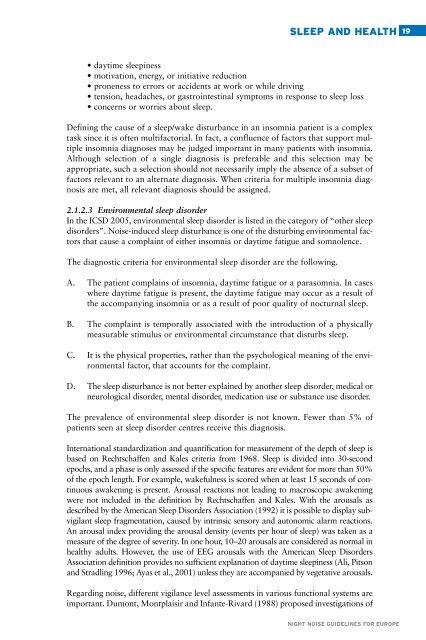Night noise guidelines for Europe - WHO/Europe - World Health ...
Night noise guidelines for Europe - WHO/Europe - World Health ...
Night noise guidelines for Europe - WHO/Europe - World Health ...
Create successful ePaper yourself
Turn your PDF publications into a flip-book with our unique Google optimized e-Paper software.
SLEEP AND HEALTH 19<br />
• daytime sleepiness<br />
• motivation, energy, or initiative reduction<br />
• proneness to errors or accidents at work or while driving<br />
• tension, headaches, or gastrointestinal symptoms in response to sleep loss<br />
• concerns or worries about sleep.<br />
Defining the cause of a sleep/wake disturbance in an insomnia patient is a complex<br />
task since it is often multifactorial. In fact, a confluence of factors that support multiple<br />
insomnia diagnoses may be judged important in many patients with insomnia.<br />
Although selection of a single diagnosis is preferable and this selection may be<br />
appropriate, such a selection should not necessarily imply the absence of a subset of<br />
factors relevant to an alternate diagnosis. When criteria <strong>for</strong> multiple insomnia diagnosis<br />
are met, all relevant diagnosis should be assigned.<br />
2.1.2.3 Environmental sleep disorder<br />
In the ICSD 2005, environmental sleep disorder is listed in the category of “other sleep<br />
disorders”. Noise-induced sleep disturbance is one of the disturbing environmental factors<br />
that cause a complaint of either insomnia or daytime fatigue and somnolence.<br />
The diagnostic criteria <strong>for</strong> environmental sleep disorder are the following.<br />
A. The patient complains of insomnia, daytime fatigue or a parasomnia. In cases<br />
where daytime fatigue is present, the daytime fatigue may occur as a result of<br />
the accompanying insomnia or as a result of poor quality of nocturnal sleep.<br />
B. The complaint is temporally associated with the introduction of a physically<br />
measurable stimulus or environmental circumstance that disturbs sleep.<br />
C. It is the physical properties, rather than the psychological meaning of the environmental<br />
factor, that accounts <strong>for</strong> the complaint.<br />
D. The sleep disturbance is not better explained by another sleep disorder, medical or<br />
neurological disorder, mental disorder, medication use or substance use disorder.<br />
The prevalence of environmental sleep disorder is not known. Fewer than 5% of<br />
patients seen at sleep disorder centres receive this diagnosis.<br />
International standardization and quantification <strong>for</strong> measurement of the depth of sleep is<br />
based on Rechtschaffen and Kales criteria from 1968. Sleep is divided into 30-second<br />
epochs, and a phase is only assessed if the specific features are evident <strong>for</strong> more than 50%<br />
of the epoch length. For example, wakefulness is scored when at least 15 seconds of continuous<br />
awakening is present. Arousal reactions not leading to macroscopic awakening<br />
were not included in the definition by Rechtschaffen and Kales. With the arousals as<br />
described by the American Sleep Disorders Association (1992) it is possible to display subvigilant<br />
sleep fragmentation, caused by intrinsic sensory and autonomic alarm reactions.<br />
An arousal index providing the arousal density (events per hour of sleep) was taken as a<br />
measure of the degree of severity. In one hour, 10–20 arousals are considered as normal in<br />
healthy adults. However, the use of EEG arousals with the American Sleep Disorders<br />
Association definition provides no sufficient explanation of daytime sleepiness (Ali, Pitson<br />
and Stradling 1996; Ayas et al., 2001) unless they are accompanied by vegetative arousals.<br />
Regarding <strong>noise</strong>, different vigilance level assessments in various functional systems are<br />
important. Dumont, Montplaisir and Infante-Rivard (1988) proposed investigations of<br />
NIGHT NOISE GUIDELINES FOR EUROPE

















